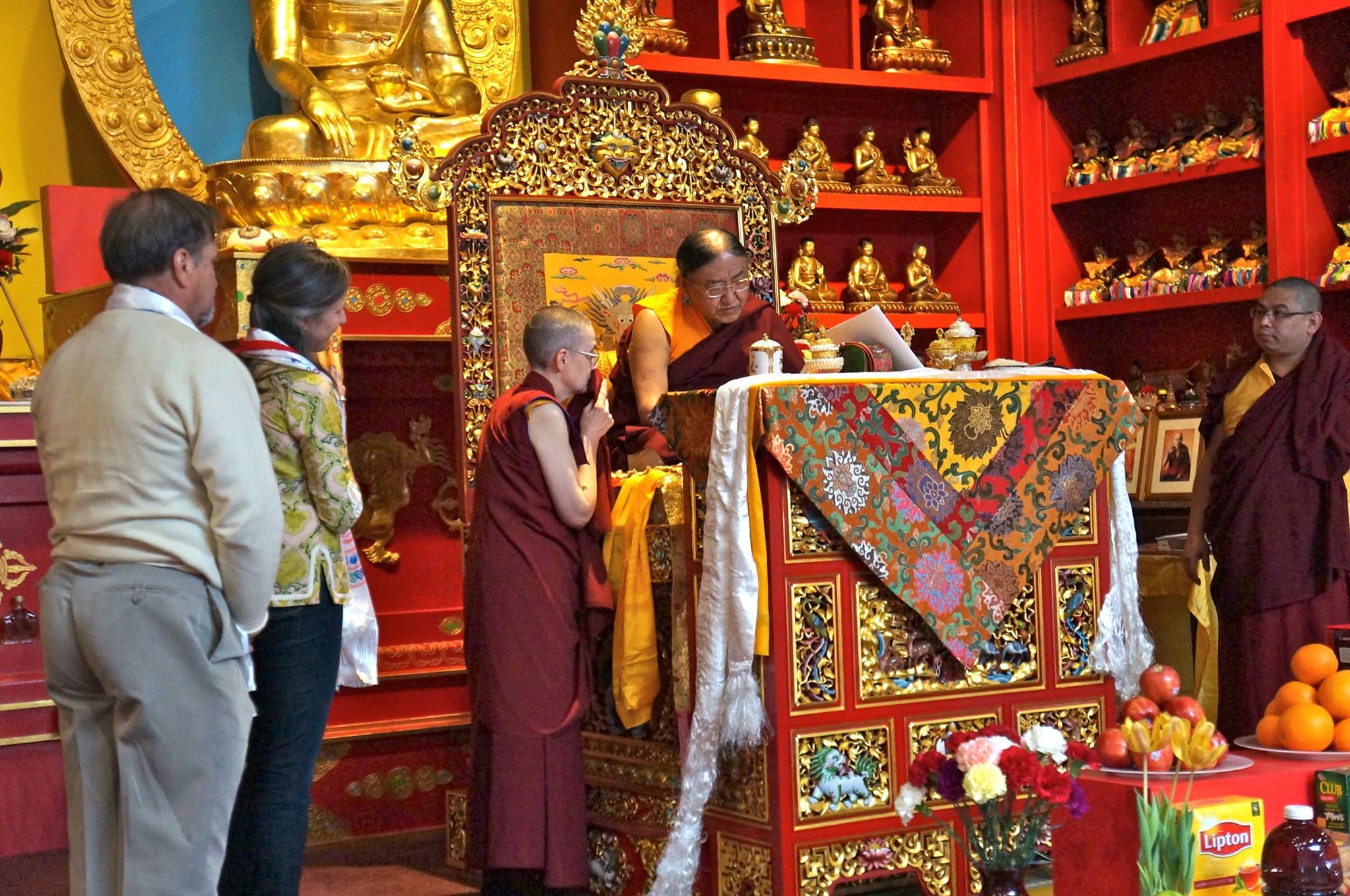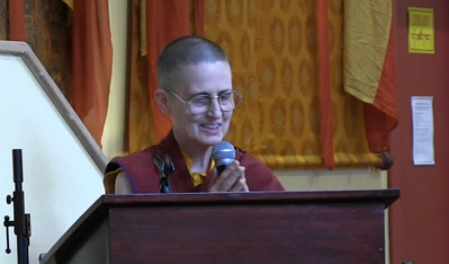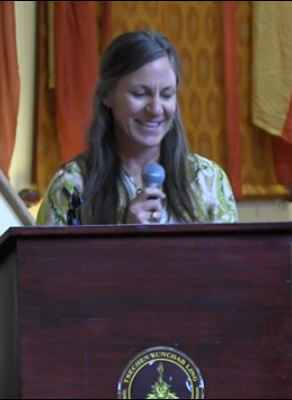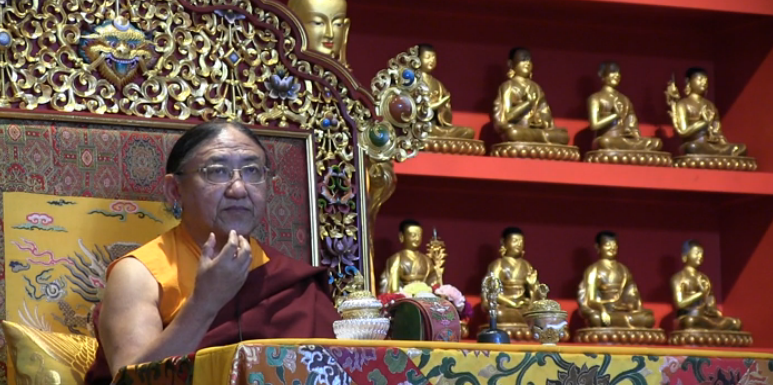84000 Sutra Resounding led by HH Sakya Trizin
“It is said that even just by doing one prostration or offering one light [to the Kangyur and Tengyur] will of course earn great merit. But the more important thing is not just only to pay respect or to keep in the shrine and to make offerings. Most important thing, we must study, through the study we must gain the blessing.” — His Holiness Sakya Trizin
 His Holiness inspects 84000’s recently translated texts.
His Holiness inspects 84000’s recently translated texts.
On April 3, 2014, His Holiness Sakya Trizin led a sutra resounding to mark the completion of his three-day teaching on “A Gift of Dharma to Kublai Khan” at Kunchab Ling in Walden, New York. Close to 100 people participated in this event.
This was the first time that a sutra resounding had been organized in New York. Sutra resounding draws inspiration from a Tibetan practice considered to be very meritorious. Traditionally, sutra resounding involves many monks reading aloud 70,000 pages of the Tibetan Buddhist Kangyur simultaneously; the written words of the Buddha are transformed into sound, and the altruistic intention of the practitioners – the readers and their patrons – reverberate along with the voices throughout the monastery and into the space beyond.
The event began with a welcome speech and introduction by Chodrung Kunga of Tsechen Kunchab Ling. She dedicated the sutra reading to the late Gene Smith, who spent his entire life searching, collecting, and digitizing Tibetan manuscripts—which laid the foundation for 84000 to translate the texts into English now. Chodrung then informed the audience of the origins of 84000, and detailed the reasons why it is important for the Buddha’s words to be translated into English.
Sarah Wilkinson, North America Team Lead for 84000, was then invited to share about 84000’s goals, and the progress and achievements to date.
His Holiness Sakya Trizin then spoke about the significance of the words of the Buddha and why there is a need for the Tibetan canon to be translated. He emphasized on the importance of reading and studying the words of the Buddha, so as to tame the mind. His Holiness then dedicated the sutra reading to the smooth progress and complete success of 84000.
Please read the transcripts of their speeches below:

Chodrung Kunga giving an opening speech.
His Holiness has been an early and strong supporter of this project from the first meeting, nearly five years ago, until now. His Holiness and the leaders of all four orders of Tibetan Buddhism have bestowed their blessings on this project. And His Holiness has supported the involvement of key translators and the Sakya order in this important work.
We’re also very happy to have this at this auspicious gathering Venerable Khenpo Kalsang Gyaltsen, our temple’s abbot, who as one of His Holiness’s translators, has also translated a number of sutras in this project, including some of the ones that you will be reading today. Khenpo Kalsang also hosted the second meeting of the working committee of the 84000 project, here in Tsechen Kunchab Ling about 4 years ago.
We dedicate today’s sutra reading to the late great western Buddhist scholar and bodhisattva Gene Smith. He made it his life work to find, to collect, study, catalogue and digitized every possible Tibetan dharma manuscript. Beginning in the 1960’s, he labored for half a century, faithfully carrying out instructions of his teacher, the very Venerable Dezhung Rinpoche, to find and save Tibetan Buddhist texts. He searched for the texts one by one, found them, saved them, and later digitized them, and put them on the web. Without his wise and compassionate efforts, most of these projects would never have become possible.
The 84000 project is the effort to translate the entire Tibetan Buddhist canon into the world’s modern languages, starting from English and then to make these translation freely available to everyone on the internet and then on other platforms, that are yet to be invented in the future.
This is a very big project and very, very important. It is a big project because as the name 84000 implies, the Buddha spoke 84,000 articles of dharma. These 84,000 teachings are known as the Kangyur. It comprises 70,000 pages. It’s a whole bookcase full of teachings spoken by Buddha. The Tibetan Buddhist canon also includes another section known as the Tengyur, which is 160,000 pages of commentaries on the sutras by the great Indian masters, such as Nagarjuna, Chandrakirti and others. Together the Kangyur and the Tengyur total 230,000 pages fills several large book cases. And you see here in our shrine across the top, the red and gold books are the Kangyur and Tengyur. This embodies the Buddha teachings.
Every day when we do prostrations, we prostrate to them. But in order for them to become the object of study here in English-speaking land, we need to translate them into English.
The 84000 project estimates that translating the Kangyur and Tengyur into English will take about a 100 years of sustained human effort by several generations of translators. But it’s not an impossible task. The Tibetans did it, translating from Sanksrit to Tibetan. It took several hundred years. The Chinese did it, it took about the same amount of time. The Mongolians, Koreans, and handful of other civilizations, cared enough for the Buddhist teachings to translate the entire Buddhist canon, too. But the 84000 project expects that this time, hopefully, it will take only a hundred years, which is much shorter. Due to technology, we don’t have to grind the ink, we don’t have to manufacture paper or walk to India to obtain the text.
So now in our time, in our language, we have this great historic project once again to translate the entire canon. All of us here today have very good karma to participate in this event in these early stages. May we participate in this project again and again in our future lives, because it will take several of our lifetimes before the project is complete.
As I mentioned, translating the Tibetan Buddhist canon from Tibetan to English is a very important project. For this reason, His Holiness and all the heads of Tibetan Buddhism have blessed the project.
One of the reasons why, in their wisdom and compassion, they know it to be so important, is that to be able to study and read the complete collection of Buddha’s words, it’s a necessary prerequisite for the full and authentic transmission of the dharma to be translated into the new culture and language. Until the Buddha’s words are translated, we can’t read them; without reading them, we can’t properly study them; without study, there is no correct meditation; without meditation, there is no realization.
Another reason why translating the entire Tibetan Buddhist canon is important: The Buddha’s words and commentaries by the great Indian masters are an authentic map and accurate record on how to travel on the path beyond suffering to Buddhahood.
Therefore the sutra is truly pure gold; but then this time only 9% of Kangyur and Tengyur has been translated into English – literally a small nugget of all that gold. These days, there is a continuous waterfall of books, blogs, tweets about Buddhist topics beyond produced by anyone who possess an opinion and a computer. Myself included. These trendy texts are yellow colored – sometimes even gold plated – but they are not truly solid gold like the words of the Buddha himself. In English, now we have so many Buddhist book but so few sutras; so many new opinions about Buddhism, but so little study of the classic commentaries by the great Indian masters. Until we complete the full English translation of the Kangyur and Tengyur and its authentic map to the enlightenment, the dharma in the west will easily wander along mistaken paths to look like gold but will not be truly authentic.
There’s a third reason why the effort to translate into the Kangyur into Tengyur into modern languages beginning with English is important. Great Tibetan scholars who are great masters of the Kangyur and Tengyur are now very senior in years, and many have already gone beyond our ability to receive their instructions and explanations. In addition to that, monks with high levels of literacy in Tibetan required for good translation are rapidly dwindling. It’s only in the monastery where the study of Tibetan is flourishing strongly. Therefore the translation effort must begin immediately and continue quickly, so that we can save the precious teachings of the Buddha as they were faithfully recorded into the Tibetan canon, and bring them into the modern languages while the experts to guide us are still with us.
So five years ago, the 84000 project was conceived and an international non-profit was set up to begin to translate the Tibetan Kangyur and Tengyur. Under the chairmanship of Venerable Dzongsar Khyentse Rinpoche and the very skilful leadership of Executive Director Huang Jing Rui, the project is well under way. After spending the first year carefully laying the ground work, grants were offered to qualified teams for translation work on the Kangyur.
Now well over a hundred translators at universities and monasteries have received grants. A good portion of the Kangyur is now in the process of translation. The very first publications, carefully reviewed and finalized, are now posted on the website in the 84000 online Reading Room. They are free and available to the world. A copy will be distributed to you today. I encourage you to go to the 84000 website and read the sutras, download them and share them with people. They are also available in the new Tsechen Kunchab Ling library. Tell your friends and share with them this nuggets of gold.

Sarah shares about 84000’s progress
My name is Sarah Wilkinson and I’m the North America team leader for the volunteers of 84000: Translating the Words of the Buddha. Chodroung Kunga just did such a beautiful job discussing the project and how it came into effect. I’ll be very brief and I may be a little repetitive. Some of you may have heard of the project before.As Chodrung Kunga just explained, the purpose of the project is to translate the Tibetan canon into English and other modern languages. Of course it’s an immense task. As she mentioned, it involves the translation of 230,000 pages that comprise the Kangyur and Tengyur, which is written in classical Tibetan. This classical Tibetan language is now facing threat to its survival. Only a small number of lamas, scholars and translators are alive today who have the necessary training and education to be able to make sense of the rich and complex teachings of the Buddha and his disciples in this older form of Tibetan.Our initial goal is the translation of the 70,ooo pages of Kangyur and related volumes of the Tengyur. That contains spoken words of Buddha and over 1,100 texts. Additionally we have been working very hard to create the infrastructure for consistent translation, publication and dissemination of these texts, as well as infrastructure that will allow for the education and support for future generation of translators.
Again as Chodrung Kunga said, we are incredibly fortunate to have His Holiness’ support since the very beginning, as he is one of the very first to have given his blessings and resources to our effort. The Sakya Pandita Translaton Group, which is under His Holiness’s guidance, has been integral to our success thus far.
Today we have 28 teams of 153 translators across the globe. Of the 70,000 pages of the Kangyur, we have nearly 16,000 pages either translated or in the process of translations – that’s nearly 22% of the Kangyur. Of the 17 texts published, 8 of them were translated by the Sakya Pandita Translation Group. We also have over 2 millions hits on the Reading Room by Internet users, and 68,000 texts have been downloaded from our Reading Room. Our readers come from over a 100 countries.
And while this is good news, we still have a long, long way to go. We have more works under translation than have been sponsored at this point. We hope you spread the word and encourage the sponsorship of a text, a page, or a word.
Today we will be resounding those words of the Buddha that have been translated into English by the Sakya Pandita Translation Group under the commission of 84000. Most markedly, this will be the first ever resounding in English of this group’s most recent translation, the Akarsagarba Sutra, as well as seven other works from the Kangyur translated thus far by this group.
Today, as Chodrung Kunga mentioned, His Holiness will be leading us in a mini version of the traditional resounding by reading aloud in English these newly translated words of the Buddha. On behalf of 84000, we thank you, Your Holiness, for the tremendous support you have given to 84000 in so many ways, and especially for honoring us by leading this resounding today.
May the words of the Buddha flourish and be heard by all.

HH Sakya Trizin stresses the importance of studying the words of the Buddha.
Venerable sangha members and all dharma brothers and sisters. First of all, I would like to welcome you all to this sutra reading assembly. I myself am very happy to participate in this sutra reading, because even just by one word of Buddha, to hear or to recite brings great merit.
As we all know, the source of all the happiness and benefit are the Buddha’s teachings. Lord Buddha who created [generated] the enlightenment mind for the benefit of all sentient beings and in the meantime accumulated merits and wisdom and eventually attained full enlightenment. After attaining enlightenment, he performed many great activities, such as physical activities and mental activities and so on; but the most important activity is turning the wheel of dharma – by giving the teachings.
What he has already realized, what he has gained, the wisdom he gained, he gave to the beings. What he gained, we practice. Through that, we overcome the suffering of samsara and attain liberation and enlightenment. So therefore the most important is Buddha’s voice activities.
Originally the teachings were in Sanskrit and Pali languages in India. Later, through the kind patronage of Tibetan dharma kings, and also the great blessings of Indian masters, and also through the great hardship of Tibetan translators, they were able to translate so many teachings. Probably the Tibetan collection is the most complete – as it contains Hinayana, Mahayana and Vajrayana teachings. Now the way to share this great treasure to the world is to translate.
I’m very happy this project is progressing. One of the incarnation of my great guru, the incarnation of Jamyang Khyentse Chokyi Lodro, is initiating this project. The present Dzongsar Khyentse Rinpoche is the third incarnation. The 1st Dzongsar Jamyang Khyentse Wangpo was a very great master. Although in Tibet, among many different traditions, there were innumerable masters who had great wisdom and great activities in benefiting enormous beings; but most of them are in their own field: Sakya masters in their own school, others in their own schools. They have great wisdom and also in their own fields they have great activities. But there are very few who carry the entire Buddhist tradition; and Jamyang Khyentse Wangpo is one of the few who took the entire Tibetan Buddhism – not just one school but entire school. He received the teachings from many sources, with lots of difficulty, going through lots of hardship. Not only did he receive them, but he studied and practiced them, and then later compiled them in a book, like the collection of Tantra, collection of sadhanas, collection of pith instructions, and so many different treasures. We don’t need to go anywhere. We can just receive them all very easily. Every tradition. He is really the “second Buddha,” I can call him, the second Buddha to appear in this universe.
Then the second Jamyang Khyentse Wangpo is Jamyang Khyentse Chokyi Lodro, whom myself had the fortune to meet, personally – the first time in Lhasa, and then later he came to Sakya also. I received many, many teachings. He is of course another – he carried out the same activities and same teachings as Jamyang Khyentse Wangpo did.
And now this present Jamyang Khyentse Dzongsar Rinpoche, he is the third incarnation. From a very young age he has very unique qualities. He has done so much even though he is fairly young. During this lifetime, so much teachings he received, so much things that many older lamas could not do. And now he is carrying on this 84000 project, which is very important.
I said, without the books it is difficult to study; without study, you can’t contemplate; without contemplate, you can’t meditate; without meditate, you can’t make progress. Therefore it is very important.
English is one most important languages in the world, so now to translate the entire 84000 into English is a very great project that I wholeheartedly support and rejoice the wonderful work that is going on.
The Kangyur – the collection of the Buddha’s teachings, and the collection of commentaries of the Kangyur by the great Indian masters – known as Tengyur, are both in every Tibetan monastery. Most monasteries have a copy of this too, as we have here, put it in the shrine, and then do prostration and make offering.
It is said that even just by doing one prostration or offering one light will of course earn great merit. But the more important thing is not just only to pay respect or to keep in the shrine and to make offerings. Most important thing, we must study, through the study we must gain the blessing. HH Dalai Lama pointed clearly that Kangyur is very important, very holy. We must respect, we must do prostration everything; but it is not just do the prostration. We must study, we must take them out of the shelves, we must open and study and learn and use them as textbooks, then you can gain the actual blessings.
Not only the monks and nuns but even the lay people should study also. HH Dalai Lama said, as Buddhist, now we must make the 21st century Buddhist, which means we should not just follow the traditions and do the ceremonies, worship, do prostration, make offerings, circumambulation. These are of course very meritorious and very important. But the more important, we must gain the knowledge.
The Buddha’s teaching is not just the temple or statues or offering objects. But they are in every individual’s mind and how we develop. If our mind becomes more pacified and more tamed, and we are able to control and not be controlled by our negative emotions, then we are making progress, then we are spreading the buddhadharma, then the dharma is progressing. Otherwise even though there are lots of people doing lots of practicing, but the dharma is not progressing. The progress of the dharma means the individual – we – must make progress in the practice of dharma. To do that, we need the texts. So therefore this project is very, very important. Of course it’s a very big project, but it’s an absolutely essential project. We wish this project to meet with complete success. I’m sure with the great blessing of the Buddha, Dharma, and Sangha that it will be done in great success.
And so now today, we will do recitation of the sutras. It is of course great merits. Also I feel that by doing this, it will clear the obstacles, so that the 84000 project will go very smoothly and successfully. So, by reciting the sutra here, we will dedicate it all to the project, so that it will be made with complete success; and all the leaders, directors and all the people who are directly involved in the 84000 project will completely fulfil your wishes.
See the photo slideshow from the event below:
Posted: 5 May 2014












